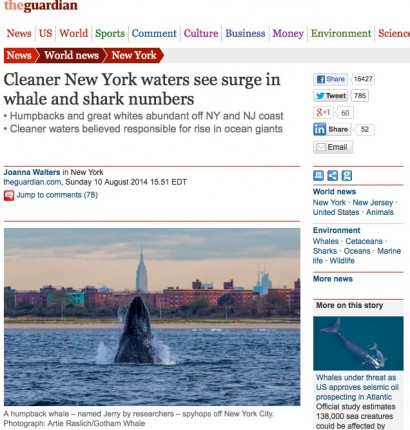Did a cleaner Hudson River attract whales to NYC?

The Guardian
View more images on our Flickr site

The Guardian
What a sight – humpback whales rising out of the ocean with the Empire State Building for a backdrop.
New York is gaining headlines as “the New Cape Cod” with surging numbers of fish, whales, seals, sharks and dolphins to go along with increasing numbers of beachgoers, boaters, fishermen, kayakers and water lovers of all stripes – thanks, it has been said, to a cleaner Hudson River.
No question that a cleaner Hudson means a better marine environment. But is that what triggered an influx of whales? Do humpbacks herald a milestone for the estuary? Hard to say.
Clearly, there is reason to celebrate the reduction in pollution since the Clean Water Act: vastly reduced sewage, more life-supporting oxygen, less debris. But our partners in the fields of marine science and biology see more questions than answers about the whale phenomenon.
(Our Facebook followers, for their part, offered alternative theories for the upsurge, ranging from climate change to “Sharknado.”)
Accounts and photos are showing the whales feeding on menhaden, a herring-like fish. “My guess is for some reason there is just a high abundance of menhaden regionally,” says John Waldman, biology professor at Queens College. “You wouldn’t get a high concentration of large, high-metabolism cetaceans without an attractive and sustained food source.”
Menhaden, which serves as the basis for a large part of the East Coast food chain, may have bounced back after a reduction in the commercial harvest allowed by the Atlantic States Fisheries Commission. Riverkeeper is part of a broad coalition that has fought to curtail overfishing of this important forage fish.
In New York Harbor, levels of sewage, pathogens and floating debris are all down. Toxic contaminants in the harbor decrease slightly every year, mixing with the sediment or washing out, while legacies of industry – Gowanus Canal, Newtown Creek, PCBs dumped by General Electric – remain a challenge, says Dennis Suszkowski, science director for the Hudson River Foundation.
It’s a mixed picture for wildlife. Striped bass and Atlantic silverside are doing well, but shad remain tragically depleted due to a combination of overfishing, habitat loss and other factors, not all of them well understood. American eel have been on the decline, Suszkowski says. Heron made a comeback in New York Harbor in the early ’90s, though the population has fluctuated since.
Industry continues to take a toll. The intakes and hot-water releases from Indian Point power plant kill over a billion fish and other aquatic life each year. Ten of 13 key species of the Hudson are in long-term decline.
Reductions of pollution are likely improving ecosystem health in the Hudson and nearby offshore areas of the New York Bight, said Philip Orton, oceanography researcher at the Stevens Institute of Technology. Oxygen increases due to sewage treatment or toxic pollutant decreases could be a factor. But so could natural ocean variability, global warming, or even changes in fishing intensity, which could all affect the numbers of menhaden supporting bigger fish in the food chain. It is a good mystery for us to focus on solving.
From Albany to the Verrazano Narrows, Montauk to Staten Island, and the Jersey Shore to the East River, the ecosystem of the Hudson River and the NY/NJ coastline is all interconnected. As such, every victory, no matter how small, contributes to the rebounding health of the whole region. That we get to see it rebound in such a majestic way is definitely one of the new benefits of living where we do.
There do seem to be more whales off our coast, Suszkowski says, having spotted one himself off Asbury Park, N.J.
“It was a nice surprise,” he said. “It was kind of spectacular to see.”
